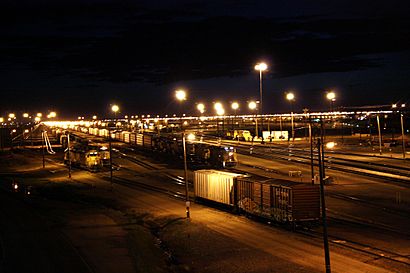Bailey Yard facts for kids
Quick facts for kids
Bailey Yard
|
|
|---|---|
| Railway classification (hump yard) and repair facilities | |

Bailey Yard illuminated at night
|
|
| Location | North Platte, Nebraska US |
| Coordinates | 41°09′N 100°50′W / 41.15°N 100.83°W |
| Owned by | Union Pacific |
| Construction | |
| Structure type | at-grade |
| History | |
| Opened | 1866 |
Bailey Yard is the biggest railroad sorting center in the world! Imagine a giant puzzle where thousands of train cars need to be put in the right order. That's what happens here. Workers at Bailey Yard sort, fix, and get locomotives and train cars ready for trips all over North America. The Union Pacific Railroad (UP) owns and runs this huge yard, which is located in North Platte, Nebraska. It's named after Edd H. Bailey, a former president of Union Pacific.
Contents
What Makes Bailey Yard So Big?
A Massive Rail Hub
Bailey Yard is located right in the middle of the United States, between Denver and Omaha. It's incredibly large, covering an area of about 2,850 acres (4.45 sq mi; 11.5 km2). That's like having 2,155 American football fields all in one place! The yard stretches for over 8 miles (13 km) and is about 2 miles (3.2 km) wide at its widest point.
Tracks, Switches, and People
This giant facility has 200 separate tracks, which add up to an amazing 315 miles (507 km) of track. There are also 985 switches and 766 turnouts to guide the trains. More than 2,600 people work in North Platte, and most of them help keep Bailey Yard running every day.
How Trains Are Sorted
The Hump Yard System
Every day, about 139 trains and over 14,000 railroad cars travel through Bailey Yard. The yard sorts around 3,000 cars daily using a special system called a "hump yard." This system uses two large mounds, or "humps." The eastbound hump is 34 foot (10 m) tall, and the westbound hump is 20 feet (6.1 m) high.
Sorting Cars Quickly
When a train car goes over a hump, gravity helps it roll down into one of 114 "bowl" tracks. This process can sort four cars every minute! These bowl tracks are where new trains are put together. These new trains then head to places all over North America, including the East, West, and Gulf coasts of the United States, and even to Canada and Mexico.
Keeping Trains in Top Shape
Fueling and Repair Shops
Bailey Yard isn't just for sorting; it's also a major repair and service center. There are three fueling stations that service over 8,500 locomotives each month. A special shop can repair 750 locomotives monthly, and another facility can fix nearly 50 train cars every day. This car repair shop replaces 10,000 wheel-sets each year!
High-Tech Inspections
The yard uses amazing technology to keep trains safe. One special detector uses ultrasound to check each wheel for tiny problems while the train is moving. It's the only detector like it in the world! Workers can also change wheels on empty coal trains very quickly. They use a hydraulic jack to lift the cars and replace the wheels in just 8–12 minutes.
Fast Pit Stops for Locomotives
Locomotives get a "pit stop" similar to what you might see in a NASCAR race. A team of five experts—an electrician, machinist, fireman, oiler, and car inspector—works together. They can service a locomotive in just 45 minutes, without even unhooking it from its train!
History of Bailey Yard
A Railroad Town Is Born
The town of North Platte was first planned as a railroad town in 1866 by chief engineer Grenville Dodge. He chose the spot because it had good water and was a good distance from Grand Island, Nebraska. The first train arrived in North Platte in 1866. Dodge then built important shops and winter homes for the train crews.
Growing Over the Years
North Platte became a key spot for Union Pacific. Trains were sorted here, crews changed, and equipment was fixed. The yard was updated in 1948 to become a hump yard with 42 tracks. More tracks and shops were added in the 1960s and 1970s. In 1980, the 1948 hump yard was replaced with an even newer, larger one.
World Record Holder
In 1995, Bailey Yard was officially recognized in the Guinness Book of Records as the largest rail yard in the world! It was even featured on the "Freight Trains" episode of Modern Marvels on The History Channel.
See also
- List of rail yards

